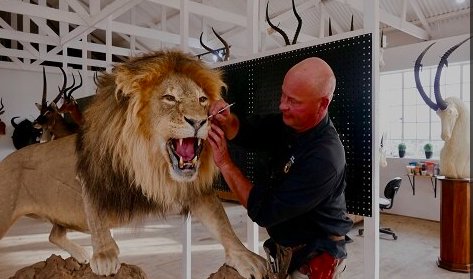
The art of taxidermy, an age-old practice, stands at the crossroads of science and art. This comprehensive exploration, spanning 6000 words, delves into the intricate world of taxidermist jobs. From the historical roots of taxidermy to the modern challenges and artistic pursuits of taxidermists, this journey aims to unravel the fascinating world of preserving nature’s artistry.
Historical Roots of Taxidermy
1 Ancient Practices
The origins of taxidermy can be traced back to ancient civilizations where animals were preserved for religious or decorative purposes. Techniques evolved over time, with cultures like the Egyptians and Greeks contributing to early taxidermic practices.
2 Renaissance Revival
The Renaissance period witnessed a revival of interest in the natural world, leading to advancements in taxidermy. Collections of preserved specimens became popular among scholars, setting the stage for taxidermy as a scientific pursuit.
3 The Victorian Era and the Rise of Taxidermy as Art
The Victorian era saw taxidermy emerge as a popular art form, with naturalists and artists collaborating to create elaborate displays. The demand for taxidermists rose as museums and private collectors sought lifelike representations of wildlife.
Educational Pathways to Becoming a Taxidermist
1 Informal Apprenticeships
Historically, taxidermy skills were often passed down through informal apprenticeships. Aspiring taxidermists learned techniques from experienced practitioners in workshops or studios.
2 Formal Training Programs
In contemporary times, formal training programs in taxidermy have become available. These programs cover anatomy, sculpting, and the intricacies of preserving specimens, providing a structured pathway to acquiring skills.
3 Continuous Learning and Specialization
The field of taxidermy is vast, and taxidermists often engage in continuous learning to stay abreast of new techniques and materials. Some choose to specialize in particular types of specimens, such as birds, mammals, or fish.
The Art and Science of Taxidermy
1 Preservation Techniques
Taxidermists employ various preservation techniques, including skinning, fleshing, tanning, and mounting. Each step requires precision and a deep understanding of anatomy to create lifelike and anatomically accurate specimens.
2 Mounting and Sculpting
The artistry of taxidermy extends to the mounting process. Taxidermists sculpt manikins to accurately reflect the posture and anatomy of the specimen. Attention to detail in features like eyes and facial expressions adds a lifelike quality.
3 Artistic Expression in Composition
Beyond technical skill, taxidermy allows for artistic expression in composition. Taxidermists may create dynamic scenes, portraying animals in their natural habitats, adding an extra layer of storytelling to their work.
Challenges Faced by Taxidermists
1 Ethical and Legal Considerations
Taxidermy often involves working with animal specimens, raising ethical considerations about the sourcing of materials. Adhering to legal regulations regarding the acquisition of specimens is a constant challenge.
2 Changing Perceptions and Stigmas
Public perceptions of taxidermy can vary, with some viewing it as an art form celebrating nature’s beauty and others associating it with a macabre fascination. Taxidermists navigate these perceptions and work towards fostering understanding.
3 Environmental Conservation and Responsibility
As awareness of environmental conservation grows, taxidermists face the challenge of promoting ethical practices. Many taxidermists emphasize the importance of sourcing specimens ethically and contributing to conservation efforts.
Artistic Pursuits in Modern Taxidermy
1 Contemporary Art Installations
Modern taxidermists are breaking traditional molds by incorporating taxidermy into contemporary art installations. These pieces often carry deeper messages about nature, conservation, and the human impact on the environment.
2 Collaborations with Artists
Collaborations between taxidermists and other artists, such as sculptors, painters, and photographers, have given rise to interdisciplinary artworks that challenge conventional notions of taxidermy and push artistic boundaries.
3 Educational Outreach and Public Engagement
Some taxidermists engage in educational outreach to demystify their craft and foster an appreciation for the art and science of taxidermy. Workshops, exhibitions, and online platforms contribute to public understanding.
The Business of Taxidermy
1 Private Studios and Commissioned Work
Many taxidermists operate private studios, accepting commissions from individuals, museums, or institutions. Commissioned work may include preserving trophies, creating museum displays, or crafting bespoke art pieces.
2 Commercial Taxidermy Supplies
The commercial side of taxidermy involves supplying materials and tools to taxidermists. Companies specializing in taxidermy supplies offer a range of products, from manikins and eyes to tanning agents and sculpting tools.
3 Online Platforms and Marketing
Taxidermists utilize online platforms to showcase their work, connect with clients, and market their services. Social media, in particular, has become a powerful tool for sharing behind-the-scenes glimpses and attracting a global audience.
Future Trends in Taxidermy
1 Incorporation of Technology
Advancements in technology, such as 3D scanning and printing, may influence the future of taxidermy. These technologies could enhance precision in creating replicas and offer new possibilities for artistic expression.
2 Sustainability Practices
An increasing focus on sustainability in taxidermy involves using ethically sourced materials, promoting conservation awareness, and contributing to environmental initiatives. Sustainable practices are becoming integral to the ethos of many taxidermists.
3 Diversification of Artistic Styles
The future of taxidermy may witness a continued diversification of artistic styles. Taxidermists may explore unconventional materials, reimagine traditional displays, and collaborate across artistic disciplines.
Conclusion: Crafting Nature’s Symphony
Acknowledging Taxidermists as Artists and Guardians of Nature
Taxidermists, as artists and guardians of nature’s beauty, deserve acknowledgment for their role in preserving and celebrating the intricacies of the natural world.
Advocating for Ethical Practices and Conservation
Emphasizing ethical practices, responsible sourcing, and contributing to conservation initiatives positions taxidermists as advocates for the environment and stewards of biodiversity.







